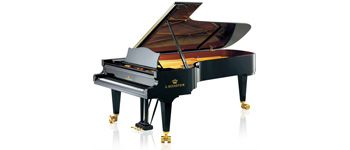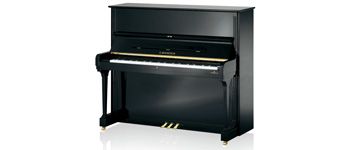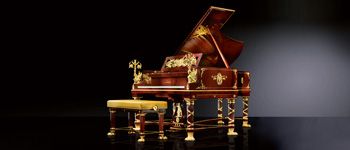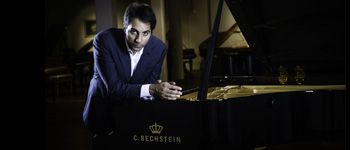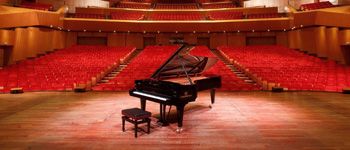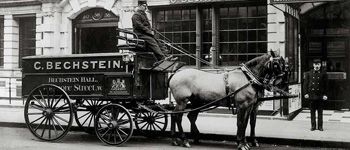Bechstein-Tradition
Highest quality since 1853. Browse through the history of our company.
Post-war Berlin: view of the C. Bechstein manufactory in Reichenberger Strasse
The new beginning
The Second World War is a disaster for Germany in general and Bechstein in particular. Berlin is repeatedly the target of large air raids by the Royal Air Force and the US Air Force that destroy not only the factory in Reichenberger Strasse, but also the major part of the company’s stocks of wood.
After the end of the war, the ruins of the Bechstein factory are located in the American sector of Berlin. The US military authorities commandeer the remaining production facilities and place the company under trusteeship until 1951. Lieselotte and Edwin Otto Bechstein, Helene’s children, inherit their mother’s shares after her death, but these remain under US control. In 1963, most of them, as well as shares of the Golddiskontbank, are handed over to the Cincinnati-based piano manufacturer Baldwin. Edwin Otto Bechstein will sell his twenty-five percent of the company’s shares to Baldwin in the 1970s.
Immediately after the German capitulation, the occupation authorities compel Bechstein to use its remaining stocks of wood to make coffins — a decision with a highly symbolic dimension. The policy of the US occupying forces follows various goals at that time: on the one hand “re-educating” the Germans and teaching them democracy, on the other acquiring German patents to be exploited by the civil and military industries while opening the German market for US products.
Two iconic photographs that illustrate “music on the battle field” acquired worldwide fame and now belong the collective memory. The first picture shows an American soldier nonchalantly leaning on a dirty grand piano, Wagner’s instrument in Villa Wahnfried after the seizure of Bayreuth by the US Army. The second photograph pictures happy GIs singing around an upright, the Victory Vertical model specially built by Steinway for the purpose of entertaining the troops. Under such conditions, it is easily understandable that the new beginning will be anything but simple for C. Bechstein.
A difficult relaunch
Piano production does not resume until December 1951, more than six years after the end of the war. Within the framework of the European Recovery Programme, or Marshall Plan, the company was granted credits, could acquire a modern machine park and moved to a new production site of eight thousand square metres. Despite the war damage, it still has a stock of precious raw materials: wood cut in the 1930, including valuable planks from Romanian trees that are excellent for making pinblocks and soundboards.
Two years later, C. Bechstein organises a dazzling event to celebrate its 100th anniversary at the Titaniapalast, the venue that provisionally hosts Berlin Philharmonic Orchestra directed by Wilhelm Furtwängler. The hall is overcrowded on 21 November 1953 as Wilhelm Backhaus plays five works by Beethoven, including the profound Piano Sonata No 32, op. 111.
Sales remain relatively moderate in the early 1950s, but the pianos integrate the traditional Bechstein quality. In 1954, conductor Sergiu Celibidache buys a short grand piano for his Mexico City residence and is immediately fired with enthusiasm. And in 1957, the third Bechstein exported to Japan is acquired by none other than Yamaha, who uses the instrument in its own concert hall. The economic activity is so favourable that the board decides to build a second factory in October 1954. Just a few months later, the Messina Declaration paves the way to the foundation of the Common Market, so that when the new production site is inaugurated in Karlslruhe-Killisfeld in October 1959, the European Economic Community — the precursor of today’s EU — has existed for two years under the Treaty of Rome. The decision to build this new factory with a total area of 1800 square metres is particularly judicious as West Berlin is cut off from the rest of the Federal Republic after the construction of the Berlin Wall in August 1961, which results in a lack of skilled workers in the former German capital city.
In the late 1960s, the Berlin and Karlsruhe factories make nearly one thousand instruments a year with revenues of approximately 4.5 million marks. The commercial results are highly satisfactory, so that the board decides to build a third factory in Eschelbronn, also in Baden-Württemberg. By that time Bechstein is exporting nearly half of its production, but the customers are waiting up to six months for delivery.
